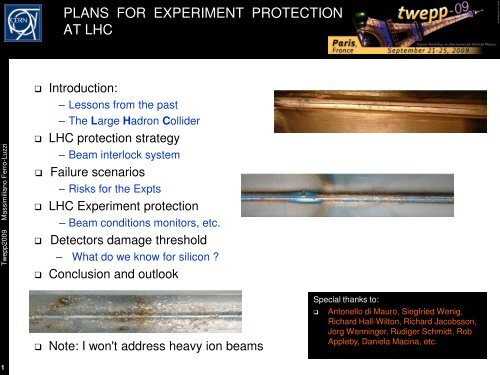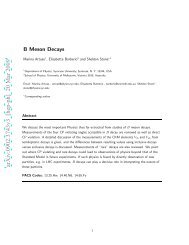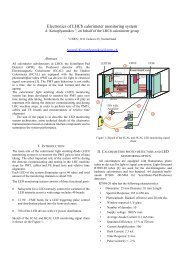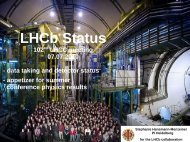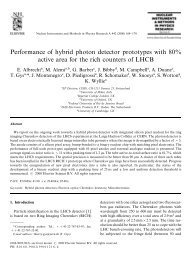PLANS FOR EXPERIMENT PROTECTION AT LHC - LHCb - Cern
PLANS FOR EXPERIMENT PROTECTION AT LHC - LHCb - Cern
PLANS FOR EXPERIMENT PROTECTION AT LHC - LHCb - Cern
You also want an ePaper? Increase the reach of your titles
YUMPU automatically turns print PDFs into web optimized ePapers that Google loves.
Twepp2009 Massimiliano Ferro-Luzzi<br />
1<br />
<strong>PLANS</strong> <strong>FOR</strong> <strong>EXPERIMENT</strong> <strong>PROTECTION</strong><br />
<strong>AT</strong> <strong>LHC</strong><br />
Introduction:<br />
– Lessons from the past<br />
– The Large Hadron Collider<br />
<strong>LHC</strong> protection strategy<br />
– Beam interlock system<br />
Failure scenarios<br />
– Risks for the Expts<br />
<strong>LHC</strong> Experiment protection<br />
– Beam conditions monitors, etc.<br />
Detectors damage threshold<br />
– What do we know for silicon ?<br />
Conclusion and outlook<br />
Note: I won't address heavy ion beams<br />
Special thanks to:<br />
Antonello di Mauro, Siegfried Wenig,<br />
Richard Hall-Wilton, Richard Jacobsson,<br />
Jorg Wenninger, Rudiger Schmidt, Rob<br />
Appleby, Daniela Macina, etc.
Twepp2009 Massimiliano Ferro-Luzzi<br />
2<br />
It happens ...<br />
SppS:<br />
– 198x: electrostatic separators adjusted for 315 GeV, instead of injection energy of 26 GeV<br />
=> UA2 gets beam injected repeatedly into detector, no fast feedback from the Expt<br />
LEP:<br />
– 1991: Quad polarity switched... consecutive splashes into L3, damage to BGO lumimonitor<br />
(later, in 1992, further failures with damage to endcap calorimeter...)<br />
– 1993: Quad failure ... Aleph loses fraction of VDET due to shorting of AC capacitor chips<br />
RHIC:<br />
– 2000: Phobos: several missed aborts, lose 1-2% of their Si pad detector channels<br />
(other RHIC experiments affected as well).<br />
HERA:<br />
– 2002: damage caused to H1 Si pad and strip detectors (BST) and their electronics.<br />
Tevatron:<br />
– 2002: asynchronous dump, CDF loses six ladders of vertex detector due to chip failure<br />
Lessons:<br />
it does happen!<br />
better have a protection system in the experiment to trigger beam abort<br />
See J. Spalding in TeV4<strong>LHC</strong> April 2005<br />
better have some sort of monitor during injection (fast feed back to machine!)
Twepp2009 Massimiliano Ferro-Luzzi<br />
3<br />
Stored Energy of the <strong>LHC</strong><br />
A factor 2 in magnetic field<br />
A factor 7 in beam energy<br />
A factor 200 in stored energy!<br />
4x72x1.1 10 11 p<br />
360 MJ<br />
2808x1.1 10 11 p<br />
<strong>LHC</strong><br />
2009-<br />
2010<br />
target
Twepp2009 Massimiliano Ferro-Luzzi<br />
4<br />
<strong>LHC</strong> colleagues performed a controlled<br />
experiment with 450 GeV beam shot<br />
into a stack target to benchmark<br />
simulations.<br />
Copper:<br />
Damage Potential of <strong>LHC</strong> Beams<br />
– melting point reached at ≈ 2.4x10 12 p<br />
– clear damage at ≈ 4.8x10 12 p<br />
Good agreement with simulation<br />
Definition for the <strong>LHC</strong> of a “safe” beam limit (setup beam, see later):<br />
10 12 protons at 450 GeV<br />
10 10 protons at 7 TeV (scaled from 450 GeV)<br />
1.2 2.4 7.2 4.8 x10 12<br />
protons<br />
See V. Kain et al., Material damage test with 450 GeV <strong>LHC</strong>-type beam, Proc. of 2005 Part. Acc. Conf., Knoxville,<br />
Tennessee, and PhD Thesis by V. Kain, CERN-Thesis-2005-047<br />
about 3% of a full SPS batch<br />
Note: tests as described above do not correspond to the most typical impact of beam,<br />
there is a safety margin on the 450 GeV “safe beam” for typical accelerator equipment.<br />
But what about experiments/detectors ?
Twepp2009 Massimiliano Ferro-Luzzi<br />
5<br />
The <strong>LHC</strong> and the Experiments<br />
CMS/Totem:<br />
– near dump<br />
– roman pots<br />
<strong>LHC</strong>b and Alice:<br />
– just near injection point<br />
– experimental dipole<br />
magnets + correctors<br />
– no TAS absorbers<br />
– <strong>LHC</strong>b VELO, similar to<br />
"roman pots"<br />
<strong>AT</strong>LAS/<strong>LHC</strong>f:<br />
– a cool place to be...<br />
BEAM<br />
CLEANING<br />
RF<br />
BEAM<br />
DUMP<br />
BEAM<br />
CLEANING
Twepp2009 Massimiliano Ferro-Luzzi<br />
6<br />
Typical Insertion Region ( Region Around<br />
Experiment )<br />
Here is CMS (same for <strong>AT</strong>LAS), symmetric at IP:<br />
cryomagnet<br />
warm magnet<br />
absorber/<br />
collimator<br />
TAS = absorber to protect triplet from IP primaries NB: Q1-3 contain also some corrector dipoles<br />
Here is <strong>LHC</strong>b (similar for ALICE): injection from SPS !<br />
• No TAS<br />
• presence of dipole magnet + correctors MBXW...
Twepp2009 Massimiliano Ferro-Luzzi<br />
7<br />
<strong>LHC</strong> Machine Protection<br />
Beam modes:<br />
Outside these two beam modes,<br />
movable detectors must be OUT<br />
In this state, they should move<br />
OUT (but don't dump if not...)
Twepp2009 Massimiliano Ferro-Luzzi<br />
8<br />
<strong>LHC</strong> “Passive„ Machine Protection : Collimators<br />
/ Absorbers<br />
Almost entirely cryogenic ring<br />
– more than 20 km of superconducting magnets<br />
Quench limits impose collimation!<br />
⇒ Lost protons must be intercepted with high<br />
efficiency before quench<br />
instantaneous loss in a magnet (~10 m)<br />
required < 10 10 p at 450 GeV, 10 6-7 at 7 TeV<br />
– Unlike HERA, TEV<strong>AT</strong>RON, RHIC... the <strong>LHC</strong><br />
cannot be operated without collimators<br />
(except at injection with low intensity).<br />
– At the <strong>LHC</strong> the collimators must define the<br />
aperture (primary + secondary) which has an<br />
important impact for Machine Protection: for<br />
most multi-turn failures the beam will hit<br />
collimators first !<br />
Monitoring:<br />
– BLM’s on collimators, on magnets<br />
– BPM’s, etc.<br />
– Try avoiding quenches by setting dump<br />
thresholds lower than quench values<br />
Energy<br />
GeV<br />
Loss rate (10 h<br />
lifetime, 3x10 14 p)<br />
Quench limit<br />
(slow losses)<br />
450<br />
8.3x109 p s-1 7x108 p s-1 m-1 7000 8x106 p s-1 m-1
Twepp2009 Massimiliano Ferro-Luzzi<br />
9<br />
<strong>LHC</strong> “Active„ Machine Protection : Beam<br />
Interlocks<br />
General strategy:<br />
– inject probe bunch (5x10 9 p)<br />
– if OK (circulating), inject higher intensity batch<br />
– on dump trigger => extract beam in < 0.3 ms<br />
(1 turn ≅ 0.09 ms)<br />
Abort gap:<br />
– continuously monitored, at least 3 us long<br />
see<br />
<strong>LHC</strong> Design Report vol. 1<br />
Main Ring<br />
Beam Interlock System<br />
– Two redundant BeamPermit loops per<br />
beam around the ring<br />
– Beam Interlock Controller:<br />
Makes AND of several UserPermit signals<br />
More than 3000 <strong>LHC</strong> user devices of the BICs<br />
(BLM's, BPM's, etc.)<br />
If UserPermit signal is false, then BeamPermit is<br />
false => dump and block injection<br />
BeamPresence<br />
– one flag per <strong>LHC</strong> ring<br />
– at least 5 uA in the ring (fast AC BCT)<br />
ProbeBeam<br />
– True if SPS intensity < limit<br />
limit = C x 10 11 protons (C≤1)<br />
– if BeamPresence and ProbeBeam are<br />
false, then cannot inject into <strong>LHC</strong><br />
SetUpBeam<br />
– based on <strong>LHC</strong> current, energy dependent:<br />
True if < 10 12 (5x10 10 ) protons at 0.45 (7) TeV.<br />
If True, it allows masking some BIS inputs
Twepp2009 Massimiliano Ferro-Luzzi<br />
10<br />
Impossible Failure Scenarios ...<br />
For the experiments, these are the worries:<br />
Injection failures:<br />
– incomplete or unsynchronized kicker fire => mostly Alice & <strong>LHC</strong>b<br />
– wrong magnet settings in transfer line => mostly Alice & <strong>LHC</strong>b<br />
– wrong magnet settings in the <strong>LHC</strong> => everybody<br />
Circulating beam failures: ⇒ mostly caught by collimators<br />
– magnet failure / mishap => everybody<br />
– RF failure => everybody<br />
– collimator failure / mishap => everybody<br />
Extraction failures:<br />
– underkick, unsynchronized beam dump => mostly CMS<br />
Expect Expts to be<br />
protected by "early"<br />
cryomagnet quench<br />
protection<br />
We'll see some specific examples later
Twepp2009 Massimiliano Ferro-Luzzi<br />
11<br />
What kind of particle rates ?<br />
In terms of estimating particle rates to a detector, the only simple<br />
(though quite unlikely) <strong>LHC</strong> failure scenario is<br />
– Suppose a batch is injected with wrong magnet settings near an<br />
experiment (remember: a probe beam has < 10 11 protons)<br />
– The batch is shot straight into the detector without traversing much<br />
material (little showering, less than x10 multiplication), beam size σ ~<br />
0.3 mm<br />
– Potentially, of order ~10 13 p/cm 2 (in
Twepp2009 Massimiliano Ferro-Luzzi<br />
12<br />
Example 1: TAS Absorber Grazing Case<br />
in <strong>AT</strong>LAS<br />
<strong>AT</strong>LAS beam failures simulation:<br />
Studied wrong settings of MCBX, D1 and<br />
D2: due to presence of TAS absorber,<br />
pilot beam can never hit directly the Inner<br />
Detector.<br />
Thus, most dangerous case is when<br />
wrong magnet setting is such that beam<br />
scrapes first TAS and hits second TAS.<br />
If a 5x10 9 bunch is lost in <strong>AT</strong>LAS due to a<br />
single wrongly set magnet, the estimated<br />
radiation dose delivered to the b-layer is<br />
estimated to be<br />
< 5x10 -3 Gy or<br />
( Note: in terms of rate this is about 10 7<br />
more than during a nominal bunch<br />
crossing, i.e. ~ 10 6 MIP/cm 2 )<br />
See Dariusz Bocian, <strong>LHC</strong> Project Note 335<br />
Injection energy<br />
D1 magnet (wrong)<br />
setting (should be<br />
about 6.4%)<br />
Specially searched for<br />
Specially searched for two-magnet failures could deposit much more, but such failures are considered<br />
much less likely
Twepp2009 Massimiliano Ferro-Luzzi<br />
13<br />
Example 2: Extraction Failure and Effect<br />
on IP5<br />
Simulations for effect on CMS / IP5 due to unsynchronized abort and<br />
kicker prefire, see Drozhdin, Mokhov, Huhtinen, 1999 Particle Acc.<br />
Conference<br />
– kicker prefire: one kicker module fires alone; should not happen (system<br />
designed such that a firing module fires the other modules)<br />
– unsynchronized abort: quite likely to happen; kicker rise time ~3us<br />
=> ~120 bunches swept<br />
Results (for Pixel detector):<br />
– Integrated doses not so dangerous,<br />
– but rates are!<br />
– Up to 10 8 times higher instantaneous<br />
rates than during nominal running<br />
⇒ up to 10 8 x 10 6 MIP cm -2 s -1 !!<br />
BEAM<br />
DUMP<br />
BEAM<br />
CLEANING<br />
These results led to addition of movable and fixed<br />
collimators at IP6 (TCDQ, TCDS) to intercept the<br />
bulk of the mis-kicked beam
Twepp2009 Massimiliano Ferro-Luzzi<br />
14<br />
Example 3: ALICE Beam Failures<br />
Simulation Studies<br />
Effect of kicker failures during injection<br />
See B. Pastirčák et al., Radiation from Misinjected Beam to <strong>LHC</strong>, ALICE Internal Note 2001-03<br />
Failure scenarios:<br />
grazing: full batch (4.1x10 13 p) missing the TDI beam stopper, worst case but very unlikely<br />
sweep: prefire of kicker modules, ≈ 20 bunches escape TDI, expected several times/year (?) <br />
main contribution<br />
Results:<br />
Accumulated dose during 10 years due to "expected" misinjections is (for Si Pixel Detector and<br />
electronics) about 1 krad (1% of total dose from primary collisions)<br />
Energy deposition maps per accident in Alice detector (vertical section):<br />
rad<br />
"grazing" "sweep"<br />
cm cm<br />
cm<br />
rad<br />
Here, for Si, inner tracker:<br />
100 rad ~ 10 9-10 MIP/cm 2<br />
cm
Twepp2009 Massimiliano Ferro-Luzzi<br />
15<br />
Example 4: Wrong Compensator Setting at<br />
Injection ( here beam2 IP8 )<br />
1.0 to 0.55 of max B<br />
Nominal 0.06<br />
Beam2, 450 GeV<br />
Wrong setting of MBXWH<br />
(horizontal compensator)<br />
Beam can hit <strong>LHC</strong>b detector<br />
<strong>LHC</strong> Project Report 1174 “<strong>LHC</strong>b Injected Beam<br />
Accidents” R.B. Appleby<br />
<strong>LHC</strong> Project Report 1175 “ALICE Injected Beam<br />
Accidents” R.B. Appleby
Twepp2009 Massimiliano Ferro-Luzzi<br />
16<br />
Example 5: wrong compensator or corrector<br />
settings at injection ( here beam1 IP8 )<br />
Beam1 450 GeV<br />
Wrong MBXWH<br />
1.0 to 0.35 of max B<br />
Nominal 0.06<br />
Beam1 450 GeV<br />
Wrong MCBXV<br />
1.0 to 0.3 of max B<br />
Nominal 0.05<br />
Injected beam does not need to come from nearby injection line!<br />
Here beam 1 in <strong>LHC</strong>b (after almost one turn)<br />
Valid for all experiments at <strong>LHC</strong><br />
<strong>LHC</strong> Project Report 1174 “<strong>LHC</strong>b Injected Beam<br />
Accidents” R.B. Appleby<br />
<strong>LHC</strong> Project Report 1175 “ALICE Injected Beam<br />
Accidents” R.B. Appleby
Twepp2009 Massimiliano Ferro-Luzzi<br />
17<br />
Example 6: circulating beam D1 failure at 450<br />
GeV ( here IP8 )<br />
Separation magnet D1 going down at 450 GeV<br />
Beam mostly caught at primary collimators<br />
Here, <strong>LHC</strong>b VELO would have an aperture of 5 mm radius around<br />
the beams<br />
<strong>LHC</strong> Project Report 1176 “<strong>LHC</strong> circulating beam<br />
accidents for near-beam detectors” R.B. Appleby
Twepp2009 Massimiliano Ferro-Luzzi<br />
18<br />
Example 7: Wrong Local Bump<br />
Take again IP8 / <strong>LHC</strong>b<br />
Beams separated in Y (vertical)<br />
during filling, ramping, etc.<br />
– Typ. ~ 1 mm between beams<br />
at 7 TeV before colliding<br />
– Max. accessible separation at<br />
7 TeV is a few mm<br />
Bump can be local, transparent<br />
to rest of machine!<br />
– Example here at 7 TeV with two magnets<br />
7 TeV/beam<br />
VELO aperture<br />
Normal case<br />
Wrong (extreme) settings<br />
in 2 MCBX correctors<br />
acting coherently<br />
s/w interlocks will be in place<br />
The lower the energy, the “easier” to make such a bump<br />
– At 450 GeV => accessible separation range amplified by factor 15.5, i.e.<br />
up to few mm x15.5 !!
Twepp2009 Massimiliano Ferro-Luzzi<br />
19<br />
Beam_permit<br />
Beam_permit:<br />
<strong>LHC</strong> Experiment Interlocks<br />
In each experiment, several systems<br />
(typically 3 or 4) in “and” mode must be<br />
alive and deliver a User_permit<br />
If one system remove the User_permit, it<br />
triggers a beam dump<br />
Both beams are dumped<br />
Recovery procedure after post-mortem<br />
data analysis<br />
Injection_permit<br />
Injection_permit:<br />
Roman<br />
pots<br />
BCM<br />
+others<br />
Separate interlock based on same transmission hardware (signals to SPS extraction)<br />
Allows inhibiting injection into <strong>LHC</strong>, e.g. when<br />
– Detector not ready for injection<br />
– Bad injection detected during a fill, requires stopping injection without dumping the stored beam<br />
Magnet<br />
(emergency buttons are also implemented<br />
in some experiments…)
Twepp2009 Massimiliano Ferro-Luzzi<br />
20<br />
Typical <strong>LHC</strong> Experiment Protection System<br />
about 2 m<br />
CVD, 1 cm 2<br />
0.3-0.5 mm thick<br />
One set of diamond sensors on each side of IP:<br />
– Stand-alone system using a few polycrystalline CVD diamond pads<br />
IP<br />
– UPS powered, with few minutes autonomy<br />
– Post-Mortem analysis capability<br />
– FPGA-based dump logic:<br />
input: measured rates<br />
output: UserPermit signal<br />
– Unmaskable input to local BIC<br />
– On trigger, dump both beams<br />
– Expected ready from "day 1"<br />
– Must have high availability, reliability, efficiency<br />
a few<br />
cm<br />
1 MIP ~ 1 fC<br />
BCM (beam conditions monitor) must protect detectors against circulating beam failures
Twepp2009 Massimiliano Ferro-Luzzi<br />
21<br />
<strong>AT</strong>LAS (1)<br />
BLM<br />
Beam Loss Monitors (BLMXD.01L1/R1.CH0N_<strong>AT</strong>LAS)<br />
– 2 x 6 pCVD diamond detectors (8 x 8 mm 2 )<br />
– z = ± 345 cm and r = 65 mm<br />
– 40 µs integration time, pA to mA<br />
SIDE A towards IP<br />
SIDE C<br />
– Readout chain of <strong>LHC</strong> BLM system with modified BLMTC FPGA firmware<br />
Abort signal at front panel<br />
Receive PM signal<br />
Beam abort condition<br />
– 2 in a group of 3 detectors above threshold<br />
towards IP<br />
At nominal 1e34 cm -2 s -1<br />
Noise Collisions Thres. Damage<br />
~10 pA ~15 nA 50 nA (?) > 1 uA??
Twepp2009 Massimiliano Ferro-Luzzi<br />
22<br />
<strong>AT</strong>LAS (2)<br />
Pixel Detector<br />
Beam Conditions Monitors (BCM)<br />
BCM<br />
– 2 x 4 pCVD diamond detectors (8 x 8 mm 2 )<br />
– z = ± 184 cm and r = 55 mm<br />
– Fast readout time<br />
Beam Pipe<br />
See M. Mikuz et al.,<br />
NIMA 579 (2007) 788-794<br />
– Single MIP sensitivity with sub-ns time resolution Time of flight measurement<br />
distinguish collisions – background (∆T(A/C) = 2d/c)<br />
Beam abort condition (not used at start-up)<br />
– 3 sensors above high threshold ( 5 MIPS) AND<br />
– 4 sensors above low threshold (0.5 MIPS)<br />
A C<br />
d/c = 184 cm/c = 12.2 ns = ~ 25ns / 2<br />
Monitor beam halo by out of time signals<br />
vs collisions<br />
d
Twepp2009 Massimiliano Ferro-Luzzi<br />
23<br />
CMS (1)<br />
BCM2<br />
• Leakage current monitor<br />
• Polycrystalline Diamond<br />
• Location: z=± 14.4m, r=29cm, 4.5cm<br />
• 8 stations in ϕ, 24 sensors total<br />
see L. Fernandez-Hernando et al.,<br />
NIMA 552 (2005) 183-188<br />
BCM1L<br />
• Leakage current monitor<br />
• Polycrystalline Diamond<br />
• Usage: Experiment protection<br />
BCM1F<br />
• Bunch by bunch monitor<br />
• Single crystal Diamond<br />
• Usage: Pixel protection
Twepp2009 Massimiliano Ferro-Luzzi<br />
24<br />
CMS (2)<br />
Initially only 8 diamonds (4 per end) in inner ring on BCM2 will be “active” in<br />
asserting BEAM_PERMIT<br />
BCM1L hardware will be connected to the ABORT from the beginning,<br />
however thresholds will NOT be set until after a suitable commissioning<br />
period with beam<br />
BCM1L detectors and inner ring of BCM2 are at ca. 4.5cm radius,<br />
approximately the same as innermost layer of pixel detector<br />
Initial threshold for BCM2: RS1 ~ 10 uA (40 us)<br />
Thresholds are per diamond. No coincidence required.<br />
– Has been running stably for > 6 months, w/o spurious triggers<br />
At nominal 1e34 cm -2 s -1<br />
Noise Collisions Thres. Damage<br />
18 uA
Twepp2009 Massimiliano Ferro-Luzzi<br />
25<br />
BCM A2<br />
z = +13.5 m<br />
4 diamond sensors<br />
L<br />
BLMs<br />
VO VO-A A<br />
scintillators<br />
ALICE (1)<br />
BCM A1<br />
z = +4.5 m<br />
4 diamond sensors<br />
VO VO-C C<br />
scintillators<br />
RADMON<br />
BCM C<br />
z = -19 19 m<br />
8 diamond sensors<br />
R
Twepp2009 Massimiliano Ferro-Luzzi<br />
26<br />
ALICE (2)<br />
The UserPermit is based on BCM-CFC-TELL1 chain as in <strong>LHC</strong>b.<br />
– Fast abort on RS2 (2x40µs CFC integration frames) coincidences:<br />
Dump beam if 3 of 4 adjacent diamond sensors show current > thr RS2<br />
– Slow abort on ΣRS32 (32x40µs):<br />
Sorting out the two highest and the lowest of 8 sensors, dump beam if ΣRS32 > thr ΣRS32<br />
Current estimate for dump thresholds (to be x-checked …):<br />
– thr RS2 ~ 5000 nA , thr ΣRS32 ~ 250 nA<br />
Noise Collisions Thres. Damage<br />
Twepp2009 Massimiliano Ferro-Luzzi<br />
27<br />
<strong>LHC</strong>b (1)<br />
VELO<br />
BCM<br />
Each BCM station composed of 4 or 8 CVD diamonds<br />
Mounted on the beam pipe, about 6 cm away from beam axis<br />
Asymmetric layout of BCM around IP (space availability)<br />
Diamonds readout: integrated rates in 40 us (later upgrade to 25 ns ?)<br />
Use stand-alone readout board for algorithm on dump trigger decision<br />
Simulations ongoing (relate VELO rates to BCM rates in failure<br />
scenarios)<br />
beam pipe support<br />
diamonds<br />
Noise Collisions Thres. Damage<br />
?? uA
Twepp2009 Massimiliano Ferro-Luzzi<br />
28<br />
<strong>LHC</strong>b's Special: Vertex Locator<br />
5 mm radius<br />
21 r-phi Si modules per side<br />
0.25 mm Al foil<br />
0.25 um CMOS ASICs (Beetle)<br />
Injection: no material at r
Twepp2009 Massimiliano Ferro-Luzzi<br />
29<br />
<strong>LHC</strong>b VELO Protection System<br />
Microswitches in X on each half to check<br />
that VELO is in garage position (OUT)<br />
Read out by PLC which generates<br />
Device_out signal<br />
<strong>LHC</strong> flag Device_allowed transmitted via<br />
reliable network to the Expts. If False,<br />
movable devices must be in OUT position<br />
If both <strong>LHC</strong> flag Device_allowed and<br />
VELO flag Device_out are false, then<br />
<strong>LHC</strong>b UserPermit is false => dump the<br />
beam, prevent injection<br />
VELO motion is "slow", of order 0.1 mm/s<br />
Can move over nominal beam axis and/or<br />
beam can move to the detector!<br />
⇒ fast protection needed !<br />
⇒ BCM must detect increase in rate<br />
(over normal minimum bias events) due<br />
to a possible beam-velo foil scraping,<br />
must work for both beams<br />
"OUT" 30 mm<br />
VELO<br />
pos<br />
beam<br />
"IN" 5 mm<br />
AND<br />
⇓<br />
Device_out = true Device_out = false<br />
BCM<br />
Magnet<br />
actual beam<br />
nominal beam axis
Twepp2009 Massimiliano Ferro-Luzzi<br />
30<br />
Damage thresholds for detectors<br />
What are the most exposed / most sensitive detectors ?<br />
What are their damage thresholds ?<br />
Why do we care ?<br />
Detectors are designed, built and installed: but operation procedures<br />
can be changed<br />
– HV and LV on/off at injection or with “non-physics” circulating beam ?<br />
Feedback to the machine<br />
– Definition of intensity limit at injection<br />
Currently H/W 10 11 protons and S/W 10 10<br />
Improvements on future detectors (at even higher beam intensities...)
Twepp2009 Massimiliano Ferro-Luzzi<br />
31<br />
Risks for <strong>LHC</strong> Vertex Detectors<br />
Problems with beam losses for the silicon:<br />
Heat deposit: not a problem ? (for the likely failures)<br />
– Thermomechanicql effects ? Seeds for crqcks ?<br />
Extra radiation damage, eating up the "budget"<br />
– not so critical: <strong>LHC</strong> Si detectors designed to sustain<br />
"huge" doses (few 10 14 n eq/cm 2 ~ 10 Mrad) ;<br />
– but watch out anyway!<br />
Sudden high rate can induce large voltage in the Si<br />
detector<br />
– becomes essentially conductor => bias voltage boundary<br />
moves to another place... zap or no zap ?<br />
e.g. SiO 2 breaks at ~ 1V/nm<br />
– direct hit to FE chip can be even worse (lose full chip, i.e.<br />
many channels... see CDF accidents)<br />
The keep keep-it it-always always-on on-or or-not not dilemma:<br />
Keep detector always ON for stability ?<br />
– no charge up effects, no temperature effects, etc.<br />
Reduce risk during injection by turning OFF HV ?<br />
(or even LV off)?<br />
– unstable at turn-ON<br />
For comparison:<br />
• Atlas/CMS pixel (r=4.3cm): order of<br />
0.02 MIP/cm 2 per pp interaction<br />
• <strong>LHC</strong>b VELO: order of 0.5 MIP/cm 2<br />
per pp interaction<br />
• MIPs through pixel detectors due to<br />
pp collisions in IP1/5 in a nominal<br />
year ~ 10 17...18<br />
• One nominal <strong>LHC</strong> bunch: 10 11 p<br />
• Full nominal <strong>LHC</strong> beam: 3 x 10 14 p<br />
U bias<br />
Si<br />
insulator<br />
U bias<br />
What do we know about<br />
<strong>LHC</strong> Expt Si detector and<br />
resistance to high rates ?
Twepp2009 Massimiliano Ferro-Luzzi<br />
32<br />
High Particle Rate Tests On <strong>LHC</strong> Silicon<br />
Detectors<br />
<strong>AT</strong>LAS and CMS tests at CERN PS beam:<br />
24 GeV, 1 or few-bunch batch (bunch: 42 ns long, ~10 11 p, separation 256<br />
ns), with peak bunch density of ~ 3x10 10 p/cm 2 .<br />
Detectors biased and FE electronics ON<br />
<strong>AT</strong>LAS:<br />
– See A. Andreazza, K. Einsweiler, C. Gemme,, L. Rossi, P. Sicho, NIM A 565 (2006) 50–54,<br />
Effect of accidental beam losses on the <strong>AT</strong>LAS pixel detector<br />
CMS:<br />
– See M. Fahrer, G. Dirkes, F. Hartmann, S. Heier, A. Macpherson, Th. Müller, Th. Weiler, NIM<br />
A518 (2004) 328–330, Beam-loss-induced electrical stress test on CMS Silicon Strip Modules<br />
Laser tests (not exhaustive):<br />
Atlas silicon strip: 1064 nm LASER (1 W)<br />
– K. Hara,T. Kuwano, G. Moorhead, Y. Ikegami, T. Kohriki, S. Terada, Y. Unno, NIM A 541<br />
(2005) 15–20, Beam splash effects on <strong>AT</strong>LAS silicon microstrip detectors evaluated using 1-w<br />
Nd:YAG laser<br />
Atlas silicon strip sensors: LASER (2 types)<br />
– T. Dubbs, M. Harms, H. E-W. Sadrozinski, A. Seiden, M. Wilson, IEEE Trans. Nucl. Sci. NS47<br />
(2000) 1902, Voltages on Silicon Microstrip Detectors in High Radiation Fields
Twepp2009 Massimiliano Ferro-Luzzi<br />
33<br />
<strong>AT</strong>LAS High Particle Rate Test<br />
Andreazza et al., NIM A 565<br />
(2006) 50–54<br />
⇒ « The results of the PS<br />
experiment therefore indicate<br />
that the loss of a <strong>LHC</strong> ‘‘pilot<br />
beam’’ of 5x109 protons should<br />
not make any sizeable<br />
permanent damage to the<br />
performance of the <strong>AT</strong>LAS<br />
pixel detector. This accident<br />
will, very likely, require a<br />
reloading of the configuration<br />
parameters in a large fraction<br />
of the pixel detector. »
Twepp2009 Massimiliano Ferro-Luzzi<br />
34<br />
CMS High Particle Rates Test<br />
M. Fahrer et al., NIM A518 (2004) 328–330<br />
⇒ « There is strong evidence that CMS silicon strip modules<br />
will survive a beam loss, because the fast breakdown of<br />
bias voltage protects electronics and sensors, especially<br />
the dielectric layer and the polysilicon resistors. »
Twepp2009 Massimiliano Ferro-Luzzi<br />
35<br />
Resto Resto2 A Recent <strong>LHC</strong>b VELO High Rate Test<br />
VELO/<strong>LHC</strong>b "High Rate Test„<br />
It‘s here<br />
Main<br />
bldg
Twepp2009 Massimiliano Ferro-Luzzi<br />
36<br />
A Small Scale Experiment<br />
Module mounted close to the PS booster (PSB) beam dump<br />
Proton beam of 1.4 GeV kinetic energy<br />
Intensity from 2e9 to 9e12 p/bunch<br />
1 to 4 bunches (4 rings), we use a single bunch (ring 3)<br />
Beam spot size rms ~ 2-4 mm , bunch duration rms ~ 20-60 ns<br />
Velo module
Twepp2009 Massimiliano Ferro-Luzzi<br />
37<br />
The Victim: “Module 48”<br />
<strong>LHC</strong>b/Velo spare from production<br />
• Back-to-back R & Phi sensors<br />
• 2048 AC coupled n-on-n strips / side<br />
• 16 FE chips (IBM 0.25 µm) per side, all<br />
configured but only 8 per side read out<br />
Mounted in the beam line<br />
• Cooled to +1 ˚C (LV on) with vortex<br />
tube (8 bar compressed air)<br />
• Fluorescent screen to view the beam<br />
• Insert/retract from beam line<br />
• Remote control and read-out<br />
• Heavy radiation environment !<br />
Backsplash at every beam dump<br />
~ 1 kGy in a few months
Twepp2009 Massimiliano Ferro-Luzzi<br />
38<br />
SiO 2<br />
n<br />
p+<br />
Electrical model – static case<br />
FE inputs (2048 channels)<br />
n+<br />
R DET<br />
Al<br />
protection<br />
diodes<br />
bond wires<br />
C AC<br />
R bias<br />
C DET<br />
C G<br />
V fp<br />
C FB<br />
pre-amp<br />
RC filter<br />
QRC CRC R RC<br />
V DD bonds<br />
(16x4)<br />
GND bonds<br />
(16x5)<br />
C LV<br />
QRC CRC R RC<br />
22 nF<br />
LV (V DD)<br />
CDET = 1 nF/2048 ch.<br />
RDET = 1-100 MΩ/2048 ch.<br />
CAC = 250 nF/2048 ch.<br />
Rbias = 1 kΩ x 2048 ch.<br />
CRC = 10 nF<br />
RRC = 5 kΩ<br />
CFB = 400 fF (per ch.)<br />
C CG = 10 pF (per ch.)<br />
CLV = 32 x 100nF<br />
10 pF<br />
10 pF<br />
1 kΩ<br />
LV (GND)<br />
GND probe<br />
10 MΩ<br />
HV return (GND)<br />
10 MΩ<br />
Osc. GND<br />
HV probe<br />
HV bias (-300V)
Twepp2009 Massimiliano Ferro-Luzzi<br />
39<br />
The measurement sequence - observables<br />
Intensity steps: 2x10 9 , 2x10 10 , 2x10 11 , 2x10 12 & 9x10 12<br />
Each step: LV/HV off, LV on/HV off, LV on/HV 150 V & LV on/HV 300V<br />
Each beam ‘shot’ follows the same pattern<br />
– A set of standard measurements<br />
I/V of both sensors<br />
Noise & pedestal data<br />
Test pulse data at +1.5, +1.5, 0 and -150 V<br />
– Insert the module, acquire during the shot<br />
14 consecutive triggers of front-end data<br />
Voltage on hybrid GND and sensor bias via<br />
oscilloscope<br />
Beam spot image via a a camera<br />
– Repeat the same set of measurements<br />
Shots on two sensor positions<br />
Shots on five front-end chips<br />
(here only LV on/off matters)<br />
B15 B14<br />
B13<br />
B12<br />
B11<br />
B10<br />
B9<br />
B8
Twepp2009 Massimiliano Ferro-Luzzi<br />
40<br />
Beam images<br />
Combined R-Φ sensor<br />
front-end data<br />
Beam line camera on fluorescent screen
Twepp2009 Massimiliano Ferro-Luzzi<br />
41<br />
I/V curves<br />
I/V curves in-situ between each shot<br />
– Superimpose temperature corrected I/V curves<br />
– Small increase probably due to accumulated dose<br />
– Rough estimate between first and last curve: ~3.5x10 12 1-MeV-n eq /cm 2 (~1 kGy)<br />
Work in progress<br />
– Correlate with radiation monitoring data<br />
Leakage current increase ~ compatible with<br />
~3.5e12 1MeVn_eq/cm2 seen by whole detector<br />
due to many bcksplashes from the dump
Twepp2009 Massimiliano Ferro-Luzzi<br />
42<br />
Thermal image: No hot-spots<br />
The majority of the shots hit this area
Twepp2009 Massimiliano Ferro-Luzzi<br />
43<br />
Noise & Pedestals<br />
Noise & pedestals measured in-situ between each shot<br />
– Plots show date taken towards the end of the program<br />
– No change visible<br />
Detailed analysis is in progress
Twepp2009 Massimiliano Ferro-Luzzi<br />
44<br />
Test pulse response – post-zap<br />
Test pulse response<br />
– ‘booster’: in-situ after a couple shots (module almost fresh)<br />
– ‘lab’: lab measurement after the full program<br />
Gain difference due to different analogue drivers/receivers<br />
Bad channels identical to production QA<br />
No significant effect observed due to beam shots
Twepp2009 Massimiliano Ferro-Luzzi<br />
45<br />
Voltage across the sensor vs. time<br />
time [µs]<br />
Oscilloscope measurements<br />
– Hybrid GND<br />
– Backplane<br />
– 1 sample / ns<br />
Ground reference arbitrary<br />
– Huge ground bounce<br />
– Large pick-up<br />
– Plot V backplane-V hybridGND<br />
Two distinct features<br />
– Sharp rising edge (50 ns)<br />
– Slow charge-up
Twepp2009 Massimiliano Ferro-Luzzi<br />
46<br />
The first 50 ns …<br />
2.5 GV/s<br />
2 GV/s<br />
6 GV/s<br />
time [µs]
Twepp2009 Massimiliano Ferro-Luzzi<br />
47<br />
Shots on the FE chips<br />
56 shots on the FE chips: 2x10 9 – 2x10 11 p/bunch<br />
No destructive latch-up<br />
– Design rules include structures to prevent latch-up<br />
– Seems to be effective!<br />
SEU analysis in progress: none observed so far<br />
– Requires large energy deposited in small volume<br />
– Nuclear reactions necessary<br />
– Cross-section very low<br />
– Triple-redundant registers: corrected every 2 ns
Twepp2009 Massimiliano Ferro-Luzzi<br />
48<br />
Summary of <strong>LHC</strong>b High Rate Test<br />
The PS booster provided beam to emulate specific <strong>LHC</strong> beam<br />
injection failures<br />
– 200 ns shots (+/-2rms), 2x10 9 to 9x10 12 protons in ~1cm 2<br />
A VELO strip module was subject to a large number of shots<br />
– Two positions on the sensor, five FE chips<br />
– Different conditions on LV and HV<br />
Survived 9x1012 p on sensor with 0, 150, 300 V bias, LV on or off<br />
Survived 2x1011 p on the FE chip (LV on or off)<br />
No visible change in performance<br />
– I/V curves, noise, pedestals, thermal imaging, …<br />
Saving graces ?<br />
– The whole sensor responds as a unit<br />
– Large area sensor – many channels<br />
– CAC >> CRC (+CDET) – Protection diodes on the FE inputs<br />
– Triple-redundant registers in FE chips<br />
Analysis & measurement still in progress
Twepp2009 Massimiliano Ferro-Luzzi<br />
49<br />
Summary and Outlook<br />
<strong>LHC</strong> is very different from what has been seen so far:<br />
– new (total beam) energy domain<br />
– cannot run without collimation (cryo/quenches)<br />
Machine protection will play a key role (especially at turn-on)<br />
– passive (collimators) , active (beam interlocks, dump/inject)<br />
Expts have developed own (to some extent, common) protection system<br />
– Beam Conditions Monitor (CVD diamonds) + other detectors => dump trigger<br />
– Should take care of circulating beam failures (redundant with machine protection)<br />
– Must have high availability, reliability, efficiency<br />
– Feed-back to stop injection is implemented<br />
– Close collaboration with machine colleagues<br />
Not all possible failure scenarios for all IP's have been simulated or studied<br />
Not all exposed detectors have been stress-tested with high particle rates...<br />
– Showed some recent results on <strong>LHC</strong>b/VELO damage threshold<br />
Full chain tests ongoing (some already done)<br />
Thresholds to be set and fine tuned with beam<br />
Work in progress
Twepp2009 Massimiliano Ferro-Luzzi<br />
50<br />
vivum<br />
Post-mortem – why did it survive?<br />
Deposited energy (in 300 µm Si)<br />
– 9x10 12 x 24000 x 3.6 eV => 0.12 Joule in ~200 ns<br />
– Temperature increase in 1 cm 2 x 0.3mm Si < ~ 2 ˚C<br />
– Maximum SPS injection train (288x10 11 ): 0.4 Joule / 10 µs<br />
Local energy store: the RC filter<br />
– 10 nF @ 300V => 0.5 mJ<br />
– Absorption volume critical<br />
Massive ionisation in biased silicon<br />
– Q RC(300V) = 3 µC<br />
– Deposited charge @ 2x10 9 : 7.5 µC<br />
Possible transient damage<br />
– Current through front-end<br />
– AC coupling diode<br />
– Voltage on front-end input<br />
– Fast HV ramp-down<br />
HV bias reduced to 0 V


